Abstract
Bacteroides fragilis subsp. fragilis was maintained in a chemostat modified for anaerobic conditions to test the effects of dissolved oxygen and Eh on growth. Using a defined medium containing glucose and a dilution rate of 0.16 h -1, a stable population of 3 X 10(9) colony-forming units/ml was present. At this steady state, the pH was 5.6, the Eh was -50 mV, and the dissolved oxygen concentration was 0% atmospheric saturation. The Eh was then adjusted to +300 mV by adding potassium ferricyanide while oxygen was excluded; in this system there were no demonstrable changes from the steady state in viable cells, pH, glucose concentration, or volatile fatty acid production. In other experiments oxygen was introduced into the original steady state at a dissolved oxygen concentration of 10% atmospheric saturation for a period of 6 to 8 h. During O2 exposure, the viable cell count decreased at a rate comparable to the theoretical washout rate for a static bacterial culture. Similar results were obtained with a dissolved oxygen concentration of 25 and 100%. Other effects of O2 exposure included an increase in Eh from -50 to +250 mV, a decrease in glucose consumption, and a decrease in volatile fatty acid production. These results suggest that dissolved oxygen has a bacteriostatic effect on B. fragilis in continuous culture, which may be independent of changes in Eh alone.
Full text
PDF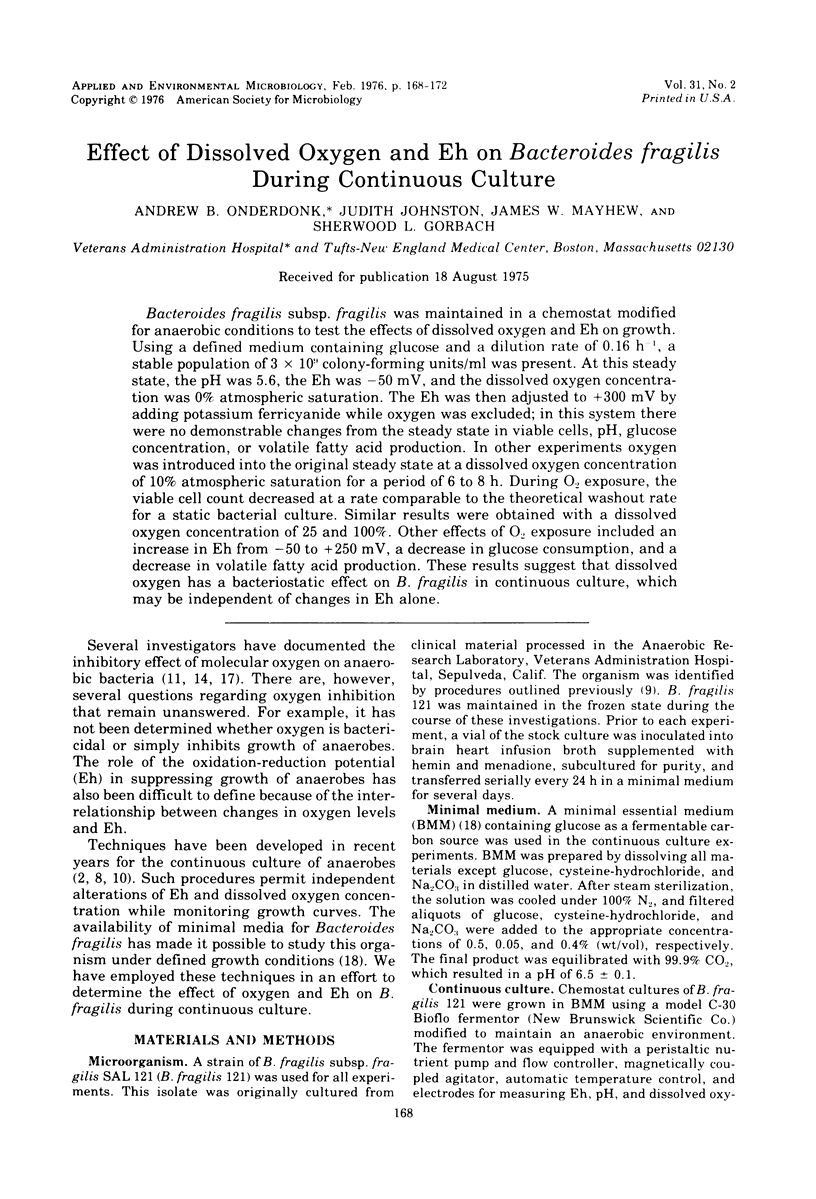
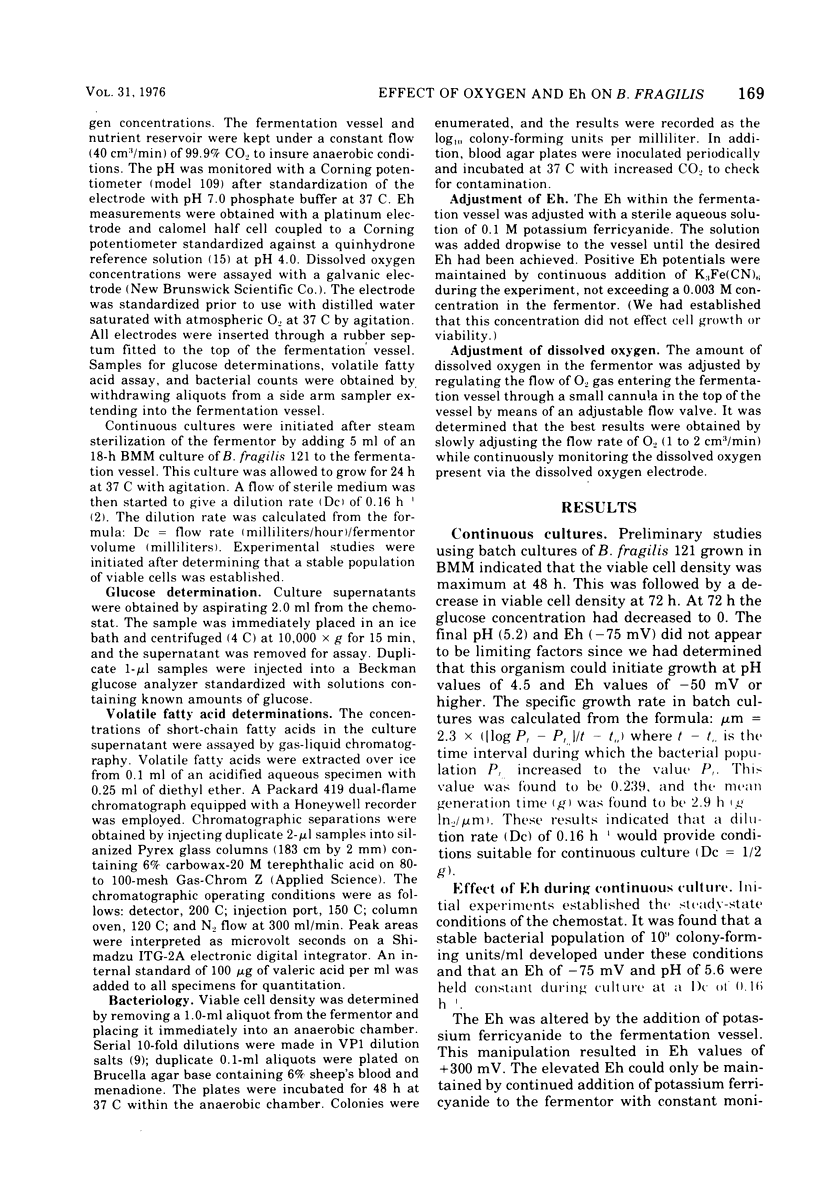
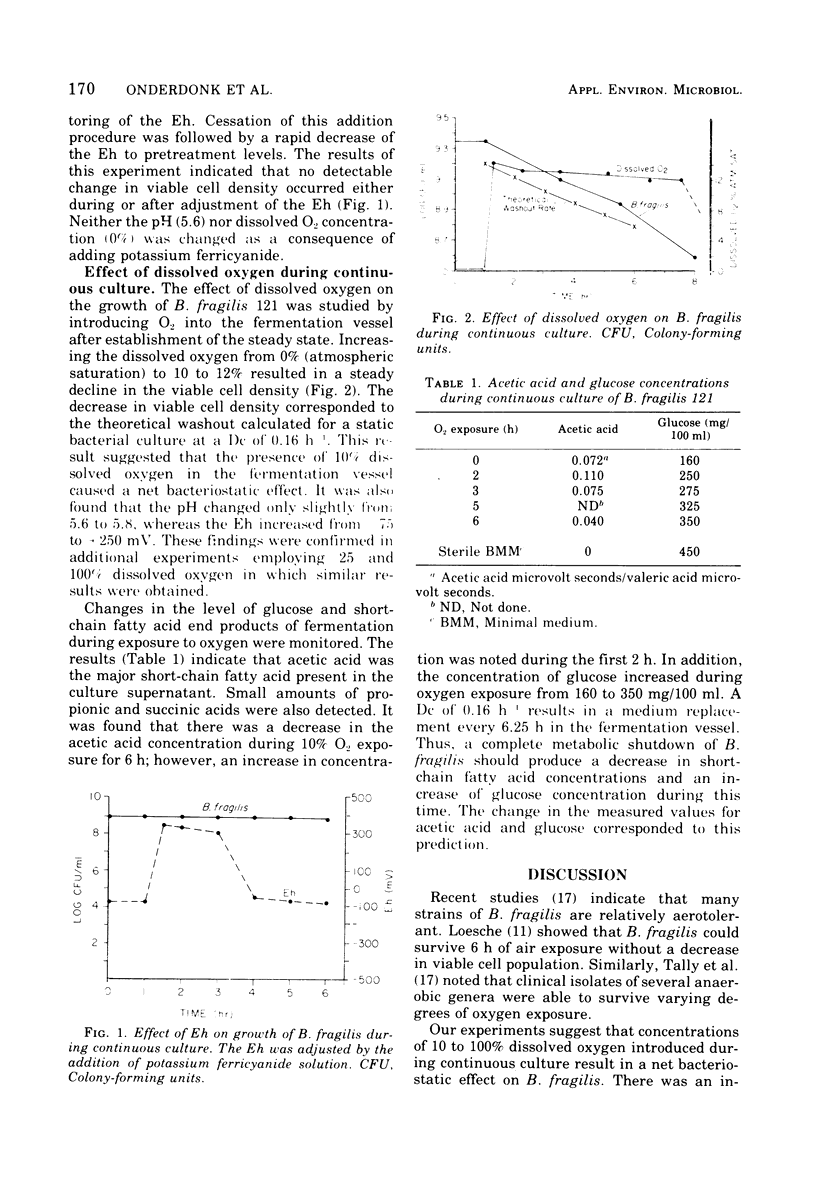
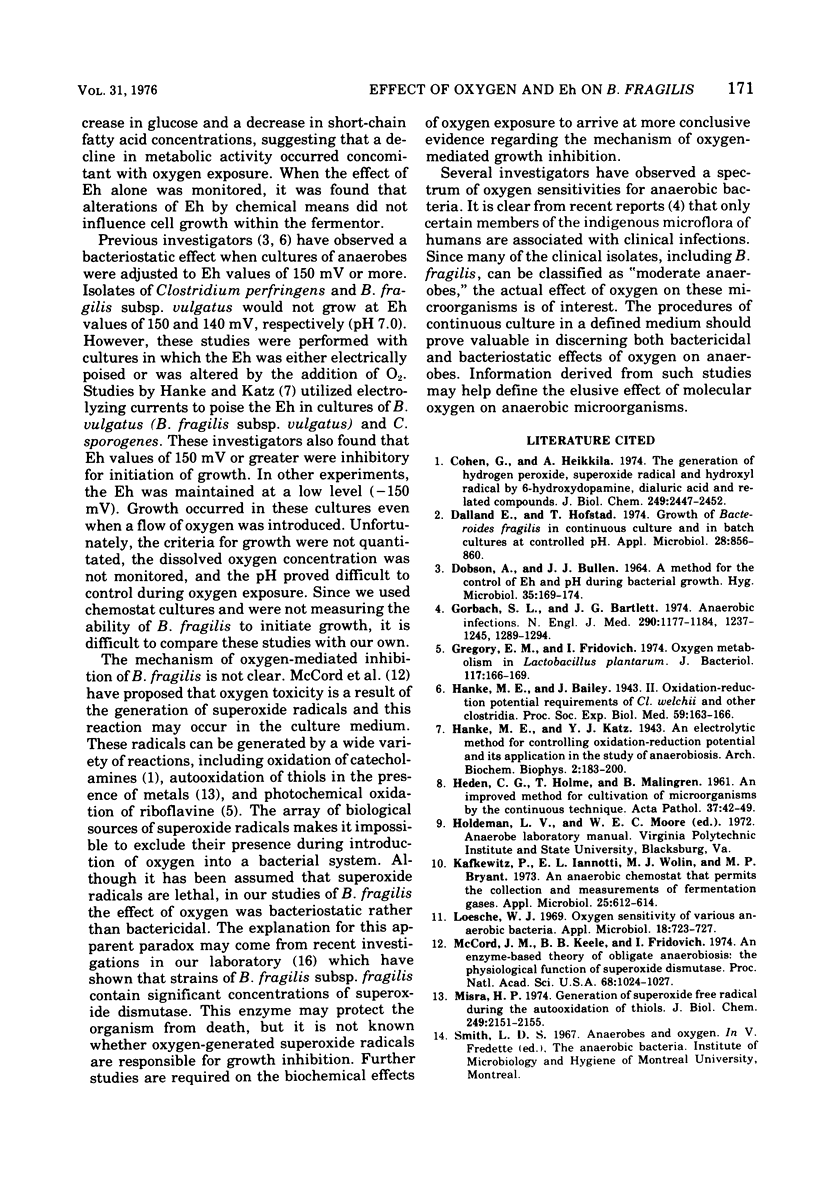
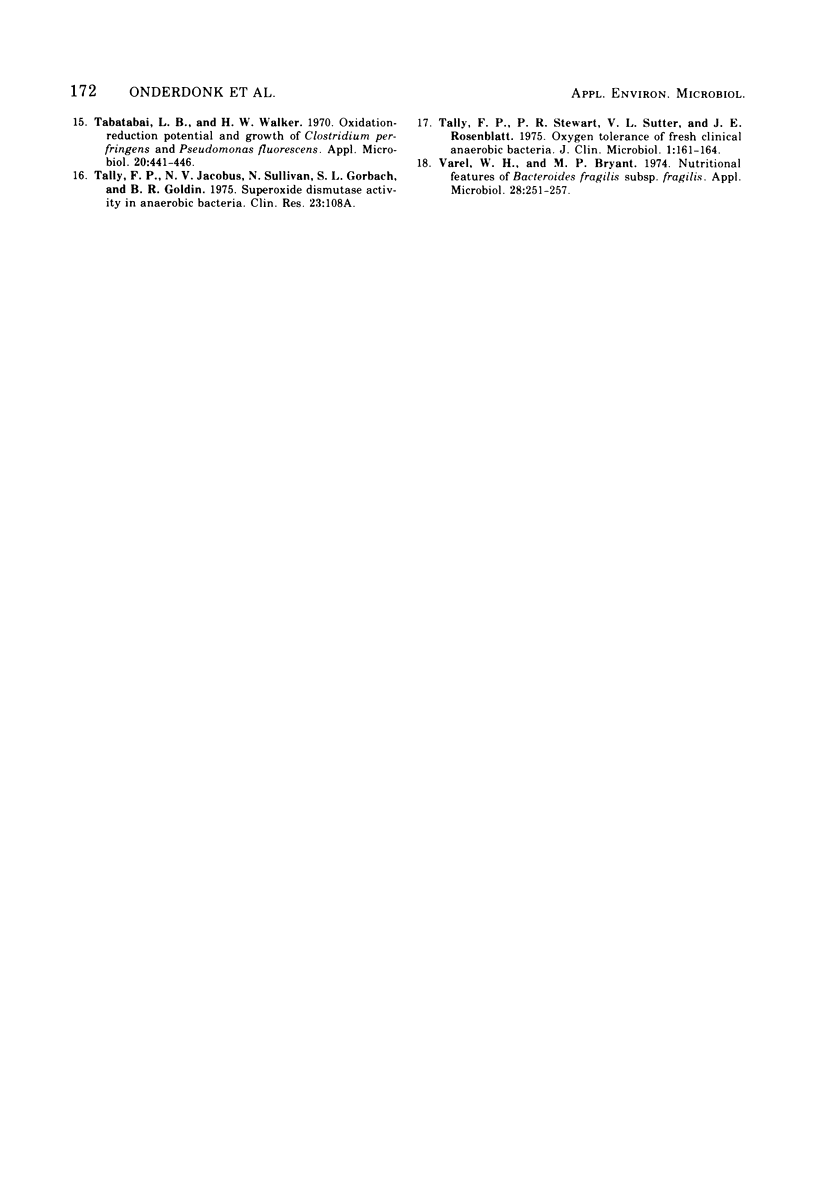
Selected References
These references are in PubMed. This may not be the complete list of references from this article.
- Cohen G., Heikkila R. E. The generation of hydrogen peroxide, superoxide radical, and hydroxyl radical by 6-hydroxydopamine, dialuric acid, and related cytotoxic agents. J Biol Chem. 1974 Apr 25;249(8):2447–2452. [PubMed] [Google Scholar]
- DOBSON A., BULLEN J. J. A METHOD FOR THE CONTROL OF EH AND PH DURING BACTERIAL GROWTH. J Gen Microbiol. 1964 May;35:169–174. doi: 10.1099/00221287-35-2-169. [DOI] [PubMed] [Google Scholar]
- Dalland E., Hofstad T. Growth of Bacteroides fragilis in continuous culture and in batch cultures at controlled pH. Appl Microbiol. 1974 Nov;28(5):856–860. doi: 10.1128/am.28.5.856-860.1974. [DOI] [PMC free article] [PubMed] [Google Scholar]
- Gorbach S. L., Bartlett J. G. Anaerobic infections. 1. N Engl J Med. 1974 May 23;290(21):1177–1184. doi: 10.1056/NEJM197405232902106. [DOI] [PubMed] [Google Scholar]
- Gregory E. M., Fridovich I. Oxygen metabolism in Lactobacillus plantarum. J Bacteriol. 1974 Jan;117(1):166–169. doi: 10.1128/jb.117.1.166-169.1974. [DOI] [PMC free article] [PubMed] [Google Scholar]
- HEDEN C. G., HOLME T., MALMGREN B. An improved method for the cultivation of micro-organisms by the continuous technique. Acta Pathol Microbiol Scand. 1955;37(1):42–49. doi: 10.1111/j.1699-0463.1955.tb00914.x. [DOI] [PubMed] [Google Scholar]
- Kafkewitz D., Iannotti E. L., Wolin M. J., Bryant M. P. An anaerobic chemostat that permits the collection and measurement of fermentation gases. Appl Microbiol. 1973 Apr;25(4):612–614. doi: 10.1128/am.25.4.612-614.1973. [DOI] [PMC free article] [PubMed] [Google Scholar]
- Loesche W. J. Oxygen sensitivity of various anaerobic bacteria. Appl Microbiol. 1969 Nov;18(5):723–727. doi: 10.1128/am.18.5.723-727.1969. [DOI] [PMC free article] [PubMed] [Google Scholar]
- McCord J. M., Keele B. B., Jr, Fridovich I. An enzyme-based theory of obligate anaerobiosis: the physiological function of superoxide dismutase. Proc Natl Acad Sci U S A. 1971 May;68(5):1024–1027. doi: 10.1073/pnas.68.5.1024. [DOI] [PMC free article] [PubMed] [Google Scholar]
- Misra H. P. Generation of superoxide free radical during the autoxidation of thiols. J Biol Chem. 1974 Apr 10;249(7):2151–2155. [PubMed] [Google Scholar]
- Tabatabai L. B., Walker H. W. Oxidation-reduction potential and growth of Clostridium perfringens and Pseudomonas fluorescens. Appl Microbiol. 1970 Sep;20(3):441–446. doi: 10.1128/am.20.3.441-446.1970. [DOI] [PMC free article] [PubMed] [Google Scholar]
- Tally F. P., Stewart P. R., Sutter V. L., Rosenblatt J. E. Oxygen tolerance of fresh clinical anaerobic bacteria. J Clin Microbiol. 1975 Feb;1(2):161–164. doi: 10.1128/jcm.1.2.161-164.1975. [DOI] [PMC free article] [PubMed] [Google Scholar]
- Varel V. H., Bryant M. P. Nutritional features of Bacteroides fragilis subsp. fragilis. Appl Microbiol. 1974 Aug;28(2):251–257. doi: 10.1128/am.28.2.251-257.1974. [DOI] [PMC free article] [PubMed] [Google Scholar]


